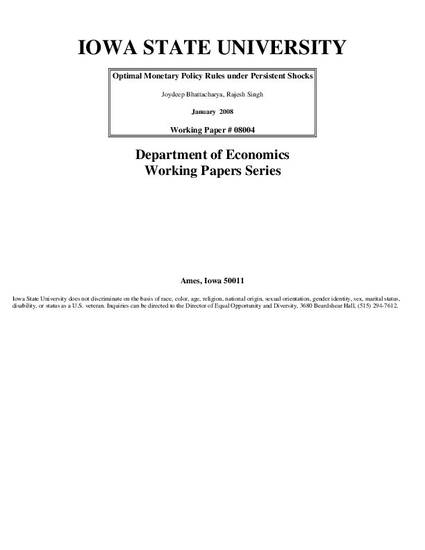
Article
Optimal monetary policy rules under persistent shocks
Economics Working Papers (2002–2016)
Document Type
Working Paper
Publication Date
1-14-2008
Working Paper Number
WP #08004, January 2008; Old working paper #12863
Abstract
The tug-o-war for supremacy between inflation targeting and monetary targeting is a classic yet timely topic in monetary economics. In this paper, we revisit this question within the context of a pure-exchange overlapping generations model of money where spatial separation and random relocation create an endogenous demand for money. We distinguish between shocks to real output and shocks to the real interest rate. Both shocks are assumed to follow AR(1) processes. Irrespective of the nature of shocks, the optimal inflation target is always positive. Under monetary targeting, shocks to endowment require negative money growth rates, while under shocks to real interest rates it may be either positive or negative depending on the elasticity of consumption substitution. Also, monetary targeting welfare-dominates inflation targeting but the gap between the two vanishes as the shock process approaches a random walk. In sharp contrast, for shocks to the real interest rate, we prove that monetary targeting and inflation targeting are welfare-equivalent only in the limit when the shocks become i.i.d.! The upshot is that persistence of the underlying fundamental uncertainty matters: depending on the nature of the shock, policy responses can either be more or less aggressive as persistence increases.
Disciplines
File Format
application/pdf
Length
43 pages
File Function
This version: January 14th, 2008 (Original version: October 3, 2007)
Citation Information
Joydeep Bhattacharya and Rajesh Singh. "Optimal monetary policy rules under persistent shocks" (2008) Available at: http://works.bepress.com/joydeep_bhattacharya/25/
